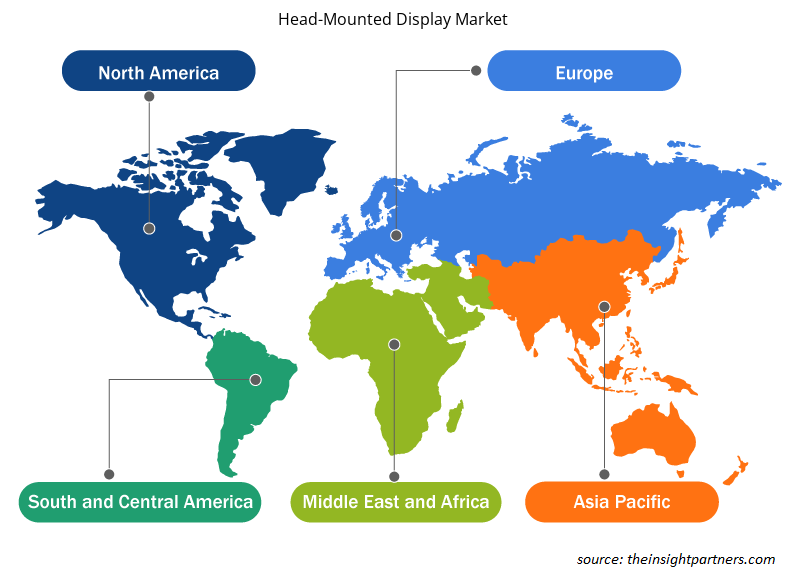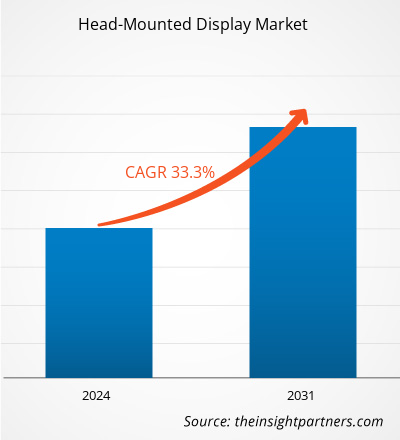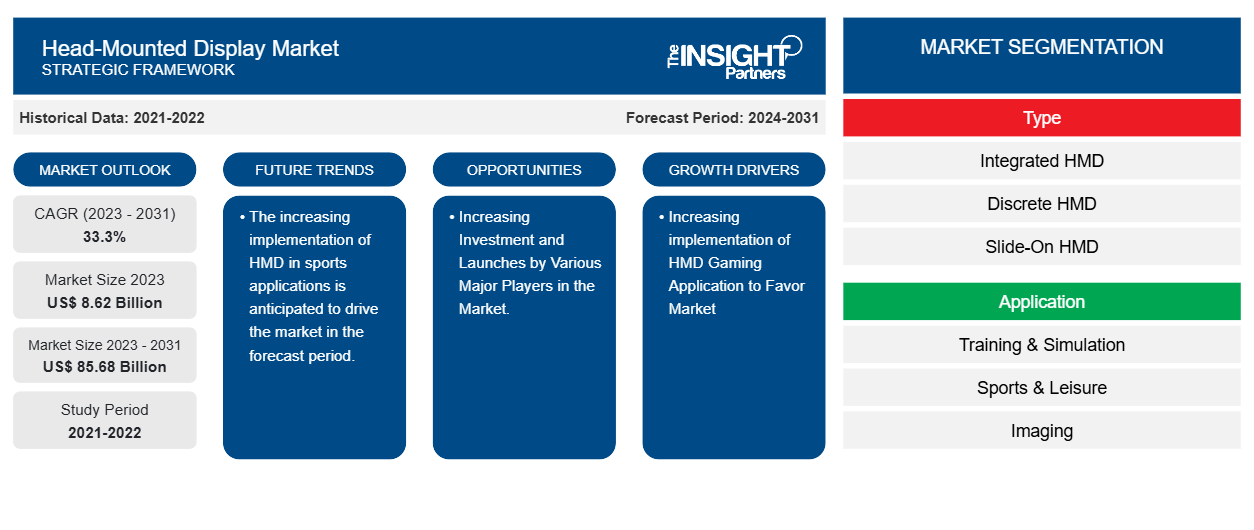Se prevé que el tamaño del mercado de los cascos de realidad virtual alcance los 85.680 millones de dólares en 2031, frente a los 8.620 millones de dólares en 2023. Se espera que el mercado registre una CAGR del 33,3 % durante el período 2023-2031. Es probable que la implementación de los cascos de realidad virtual en aplicaciones de juegos y la creciente adopción de cascos de realidad aumentada y realidad virtual en el sector militar sean los principales impulsores y tendencias del mercado.
Análisis del mercado de los cascos de realidad virtual
El mercado de los cascos de realidad virtual está experimentando un crecimiento significativo a nivel mundial. Este crecimiento se atribuye a factores como la implementación de los cascos de realidad virtual en aplicaciones de juegos y la creciente adopción de cascos de realidad aumentada y realidad virtual en el sector militar. Además, se prevé que la creciente inversión de los principales actores en el desarrollo de los cascos de realidad virtual y su implementación en aplicaciones deportivas ofrecerá varias oportunidades para el mercado en los próximos años.
Descripción general del mercado de los visores montados en la cabeza
Un visor montado en la cabeza (HMD, por sus siglas en inglés) es un tipo de dispositivo o monitor de computadora que, como su nombre lo indica, se usa en la cabeza o está integrado como parte de un casco. Este tipo de pantalla está diseñada para lograr una inmersión total del usuario en cualquier experiencia para la que esté destinada, ya que garantiza que la pantalla se mueva con el movimiento del usuario.
Personalice este informe según sus necesidades
Obtendrá personalización en cualquier informe, sin cargo, incluidas partes de este informe o análisis a nivel de país, paquete de datos de Excel, así como también grandes ofertas y descuentos para empresas emergentes y universidades.
-
Obtenga las principales tendencias clave del mercado de este informe.Esta muestra GRATUITA incluirá análisis de datos, desde tendencias del mercado hasta estimaciones y pronósticos.
Factores impulsores y oportunidades del mercado de los visores montados en la cabeza
Aumenta la implementación de la aplicación HMD Gaming para favorecer el mercado
La realidad aumentada, la realidad virtual y la realidad mixta se experimentan mediante el uso de dispositivos especiales llamados HMD. La mayoría de los HMD se basan en la técnica de visualización 3D estereoscópica. Aprovecha una señal de profundidad denominada estereopsis, que no es más que la profundidad que perciben los ojos humanos porque cada uno de nuestros dos ojos ve una escena desde una perspectiva ligeramente diferente. Las aplicaciones de juegos que aprovechan los HMD ofrecen una experiencia altamente inmersiva al crear un entorno virtual que rodea al jugador. Este nivel de inmersión es un importante argumento de venta y puede atraer tanto a jugadores ocasionales como a jugadores incondicionales. Además, las mejoras continuas en la tecnología HMD, como una mejor resolución, un campo de visión más amplio, una latencia reducida y un seguimiento mejorado, hacen que las experiencias de juego sean más realistas y agradables, lo que anima a más usuarios a adoptar estos dispositivos.
Aumento de la inversión y lanzamientos por parte de diversos actores importantes en el mercado.
Se prevé que el creciente número de lanzamientos de productos por parte de los principales actores del mercado suponga varias oportunidades para el mercado. Los lanzamientos de nuevos productos suelen venir con características avanzadas, tecnología mejorada y mejor rendimiento. Varios lanzamientos de productos, como Sony y Siemens, anunciaron que lanzarán cascos de realidad virtual para el enfoque del metaverso industrial de este último para diciembre de 2024. El producto está actualmente integrado con la plataforma de diseño de ingeniería NX de Siemens y se ampliará a otros productos. Por lo tanto, se prevé que un creciente número de inversiones y lanzamientos por parte de varios actores importantes impulse el crecimiento del mercado.
Análisis de segmentación del informe de mercado de pantallas montadas en la cabeza
Los segmentos clave que contribuyeron a la derivación del análisis del mercado de pantallas montadas en la cabeza son el tipo, la aplicación, el componente, la tecnología, el diseño y la conexión.
- Según el tipo, el mercado de los cascos de realidad virtual se divide en cascos de realidad virtual integrados, cascos de realidad virtual discretos y cascos de realidad virtual deslizables. Se prevé que el segmento de los cascos de realidad virtual integrados ocupe una cuota de mercado significativa en el período de previsión.
- Según la aplicación, el mercado de los cascos de realidad virtual se divide en formación y simulación, deportes y ocio, imágenes, defensa y seguridad, entre otros. Se prevé que el segmento de endurecimiento por radiación mediante diseño (RHBD) ocupe una cuota de mercado significativa en el período de previsión.
- Por componente, el mercado está segmentado en pantallas de visualización, controladores, sensores, cámaras y otros. Se prevé que el segmento de pantallas de visualización tenga una participación de mercado significativa en el período de pronóstico.
- Por tecnología, el mercado se segmenta en realidad aumentada, realidad virtual y realidad mixta. Se prevé que el segmento de pantallas de visualización tenga una participación de mercado significativa en el período de pronóstico.
- Por diseño, el mercado está segmentado en pantallas para montar en la cabeza y gafas ponibles. Se prevé que el segmento de pantallas de visualización ocupe una cuota de mercado significativa en el período de pronóstico.
- Por conexión, el mercado se segmenta en cableado, inalámbrico e híbrido. Se prevé que el segmento cableado tenga una participación de mercado significativa en el período de pronóstico.
Análisis de la cuota de mercado de los cascos de realidad virtual por geografía
El alcance geográfico del informe de mercado de pantallas montadas en la cabeza se divide principalmente en cinco regiones: América del Norte, Asia Pacífico, Europa, Medio Oriente y África, y América del Sur y Central.
América del Norte ha dominado el mercado de los cascos de realidad virtual. Las tendencias de adopción de alta tecnología en diversas industrias de la región de América del Norte han impulsado el crecimiento de este mercado. Se espera que factores como la mayor adopción de herramientas digitales y el elevado gasto tecnológico por parte de las agencias gubernamentales impulsen el crecimiento del mercado de cascos de realidad virtual en América del Norte. Además, un fuerte énfasis en la investigación y el desarrollo en las economías desarrolladas de los EE. UU. y Canadá está obligando a los actores norteamericanos a introducir soluciones tecnológicamente avanzadas en el mercado. Además, Estados Unidos tiene muchos actores del mercado de cascos de realidad virtual que se han centrado cada vez más en el desarrollo de soluciones innovadoras. Todos estos factores contribuyen al crecimiento del mercado de cascos de realidad virtual en la región.
Perspectivas regionales del mercado de pantallas para montar en la cabeza
Los analistas de Insight Partners explicaron en detalle las tendencias y los factores regionales que influyen en el mercado de los cascos de realidad virtual durante el período de pronóstico. Esta sección también analiza los segmentos y la geografía del mercado de los cascos de realidad virtual en América del Norte, Europa, Asia Pacífico, Oriente Medio y África, y América del Sur y Central.

- Obtenga los datos regionales específicos para el mercado de pantallas montadas en la cabeza
Alcance del informe de mercado de pantallas para montar en la cabeza
| Atributo del informe | Detalles |
|---|---|
| Tamaño del mercado en 2023 | US$ 8,62 mil millones |
| Tamaño del mercado en 2031 | US$ 85,68 mil millones |
| CAGR global (2023 - 2031) | 33,3% |
| Datos históricos | 2021-2022 |
| Período de pronóstico | 2024-2031 |
| Segmentos cubiertos |
Por tipo
|
| Regiones y países cubiertos |
América del norte
|
| Líderes del mercado y perfiles de empresas clave |
|
Densidad de actores del mercado: comprensión de su impacto en la dinámica empresarial
El mercado de los cascos de realidad virtual está creciendo rápidamente, impulsado por la creciente demanda de los usuarios finales debido a factores como la evolución de las preferencias de los consumidores, los avances tecnológicos y una mayor conciencia de los beneficios del producto. A medida que aumenta la demanda, las empresas amplían sus ofertas, innovan para satisfacer las necesidades de los consumidores y aprovechan las tendencias emergentes, lo que impulsa aún más el crecimiento del mercado.
La densidad de actores del mercado se refiere a la distribución de las empresas o firmas que operan dentro de un mercado o industria en particular. Indica cuántos competidores (actores del mercado) están presentes en un espacio de mercado determinado en relación con su tamaño o valor total de mercado.
Las principales empresas que operan en el mercado de los cascos de realidad virtual son:
- Microsoft
- Sony
- Oculus VR
- Lenovo
- Salto mágico Inc.
- Sistemas BAE
Descargo de responsabilidad : Las empresas enumeradas anteriormente no están clasificadas en ningún orden particular.

- Obtenga una descripción general de los principales actores clave del mercado de pantallas montadas en la cabeza
Noticias y desarrollos recientes del mercado de pantallas para montar en la cabeza
El mercado de los cascos de realidad virtual se evalúa mediante la recopilación de datos cualitativos y cuantitativos a partir de una investigación primaria y secundaria, que incluye importantes publicaciones corporativas, datos de asociaciones y bases de datos. A continuación, se enumeran algunos de los avances en el mercado de los cascos de realidad virtual:
- Sony y Siemens lanzarán un casco de realidad virtual para el enfoque metaverso industrial de esta última en diciembre de 2024. El producto está integrado actualmente con la plataforma de diseño de ingeniería NX de Siemens y se ampliará a otros productos. (Fuente: Sitio web de la empresa Sony, mayo de 2024)
- Sony Corporation anunció el desarrollo de un sistema de creación de contenido espacial equipado con un visor XR de alta calidad y controladores dedicados a la interacción con objetos 3D. (Fuente: sitio web de la empresa Sony Corporation, enero de 2024)
Informe de mercado de pantallas para montar en la cabeza: cobertura y resultados
El informe “Tamaño y pronóstico del mercado de pantallas montadas en la cabeza (2021-2031)” proporciona un análisis detallado del mercado que cubre las siguientes áreas:
- Tamaño y pronóstico del mercado de pantallas montadas en la cabeza a nivel global, regional y nacional para todos los segmentos clave del mercado cubiertos bajo el alcance.
- Tendencias del mercado de pantallas montadas en la cabeza, así como dinámica del mercado, como impulsores, restricciones y oportunidades clave.
- Análisis detallado PEST/Cinco fuerzas de Porter y FODA.
- Análisis del mercado de pantallas montadas en la cabeza que cubre las tendencias clave del mercado, el marco global y regional, los principales actores, las regulaciones y los desarrollos recientes del mercado.
- Análisis del panorama de la industria y de la competencia que abarca la concentración del mercado, el análisis de mapas de calor, los actores destacados y los desarrollos recientes del mercado de pantallas montadas en la cabeza
- Perfiles detallados de empresas.
- Análisis histórico (2 años), año base, pronóstico (7 años) con CAGR
- Análisis PEST y FODA
- Tamaño del mercado, valor/volumen: global, regional y nacional
- Industria y panorama competitivo
- Conjunto de datos de Excel
Informes recientes
Informes relacionados
Testimonios
Razón para comprar
- Toma de decisiones informada
- Comprensión de la dinámica del mercado
- Análisis competitivo
- Información sobre clientes
- Pronósticos del mercado
- Mitigación de riesgos
- Planificación estratégica
- Justificación de la inversión
- Identificación de mercados emergentes
- Mejora de las estrategias de marketing
- Impulso de la eficiencia operativa
- Alineación con las tendencias regulatorias























 Obtenga una muestra gratuita para - Mercado de pantallas montadas en la cabeza
Obtenga una muestra gratuita para - Mercado de pantallas montadas en la cabeza